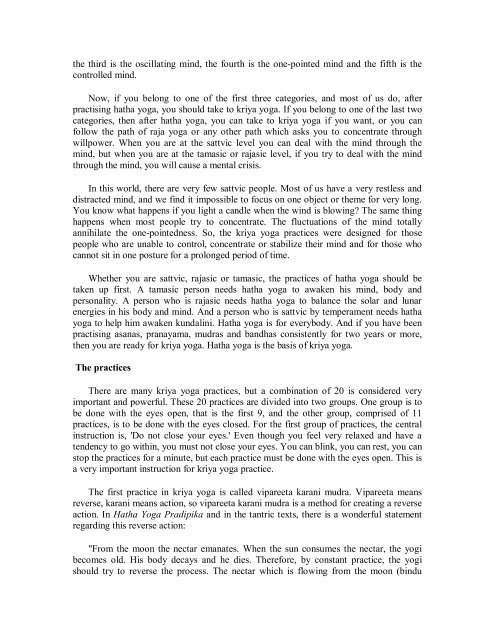Kundalini.Tantra.by.Satyananda.Saraswati
Create successful ePaper yourself
Turn your PDF publications into a flip-book with our unique Google optimized e-Paper software.
the third is the oscillating mind, the fourth is the one-pointed mind and the fifth is the<br />
controlled mind.<br />
Now, if you belong to one of the first three categories, and most of us do, after<br />
practising hatha yoga, you should take to kriya yoga. If you belong to one of the last two<br />
categories, then after hatha yoga, you can take to kriya yoga if you want, or you can<br />
follow the path of raja yoga or any other path which asks you to concentrate through<br />
willpower. When you are at the sattvic level you can deal with the mind through the<br />
mind, but when you are at the tamasic or rajasic level, if you try to deal with the mind<br />
through the mind, you will cause a mental crisis.<br />
In this world, there are very few sattvic people. Most of us have a very restless and<br />
distracted mind, and we find it impossible to focus on one object or theme for very long.<br />
You know what happens if you light a candle when the wind is blowing? The same thing<br />
happens when most people try to concentrate. The fluctuations of the mind totally<br />
annihilate the one-pointedness. So, the kriya yoga practices were designed for those<br />
people who are unable to control, concentrate or stabilize their mind and for those who<br />
cannot sit in one posture for a prolonged period of time.<br />
Whether you are sattvic, rajasic or tamasic, the practices of hatha yoga should be<br />
taken up first. A tamasic person needs hatha yoga to awaken his mind, body and<br />
personality. A person who is rajasic needs hatha yoga to balance the solar and lunar<br />
energies in his body and mind. And a person who is sattvic <strong>by</strong> temperament needs hatha<br />
yoga to help him awaken kundalini. Hatha yoga is for everybody. And if you have been<br />
practising asanas, pranayama, mudras and bandhas consistently for two years or more,<br />
then you are ready for kriya yoga. Hatha yoga is the basis of kriya yoga.<br />
The practices<br />
There are many kriya yoga practices, but a combination of 20 is considered very<br />
important and powerful. These 20 practices are divided into two groups. One group is to<br />
be done with the eyes open, that is the first 9, and the other group, comprised of 11<br />
practices, is to be done with the eyes closed. For the first group of practices, the central<br />
instruction is, 'Do not close your eyes.' Even though you feel very relaxed and have a<br />
tendency to go within, you must not close your eyes. You can blink, you can rest, you can<br />
stop the practices for a minute, but each practice must be done with the eyes open. This is<br />
a very important instruction for kriya yoga practice.<br />
The first practice in kriya yoga is called vipareeta karani mudra. Vipareeta means<br />
reverse, karani means action, so vipareeta karani mudra is a method for creating a reverse<br />
action. In Hatha Yoga Pradipika and in the tantric texts, there is a wonderful statement<br />
regarding this reverse action:<br />
"From the moon the nectar emanates. When the sun consumes the nectar, the yogi<br />
becomes old. His body decays and he dies. Therefore, <strong>by</strong> constant practice, the yogi<br />
should try to reverse the process. The nectar which is flowing from the moon (bindu














![[Lonely Planet] Sri Lanka](https://img.yumpu.com/59845622/1/169x260/lonely-planet-sri-lanka.jpg?quality=85)


